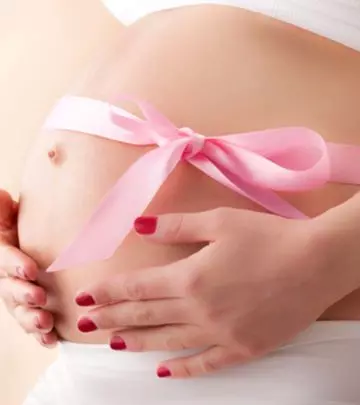
Image: Shutterstock
And, we’re at the home stretch. As you’re about to begin your third trimester, which can last until week 39 and maybe even more! However, we’ll just stick to science and assume that it’s week 36. So, let’s begin.
Week 28
Your baby forms layers of chub that improves its skin. The bones are almost developed, even though they’re soft, they’ll harden after birth.
Week 29
Muscles and lungs develop a little more while the head finally grows to make room for the growing brain.
For your baby’s nutritional intake, ensure you’re getting enough protein, vitamin C, folic acid, and iron. Calcium (milk, cheese, yogurt) is also vital as it’s a must for your baby’s bones.
Week 30
Finally, the lungs and digestive system are almost entirely developed. The baby’s vision improves as it can see its surroundings in the uterus, and it can even tell the difference between light and darkness by responding either by turning away or touching the light. Also, the baby continues to open and close its eyes.
Some studies suggest that if you expose your stomach to light, it can stimulate visual development. However, newborns aren’t usually able to see much because they can only see short distances of around 20 to 30 cm.
Week 31
The baby’s head no longer looks extra large because the arms, legs, and body grow in proportion. Until now, your baby’s movements were increasing, but now onwards until birth, the changes can reach a plateau. They don’t necessarily slow down, but the movements can change.
The organs mature because your baby can now pass water from the bladder – practice for peeing post birth. The bone marrow (mentioned previously) is now producing red blood cells, which were initially generated by the liver.
Week 32
As your baby gets plumper, its skin gets smoother. It already may have a head full of hair, or it can have a few wisps. This can change after birth, especially if the hair is thick because it may not stay for long. However, fine hair tends to stay the same.
Week 33
Your baby’s position should now change, as its head should be pointing downwards. Ensure you go for a check up because sometimes babies can turn back around.
The skull is still pliable because the bones have not fused entirely. This helps when the baby has to come out of the birth canal (cervix to vagina), which is quite narrow. However, the rest of the bones are hardening.
Week 34
The lungs are almost entirely developed whereas the central nervous system still has some developing to do.
At this point, you are encouraged to talk and read to your baby. By now, your baby can hear sounds outside of your body so don’t be shy to chat with your little one. Research even suggests that babies are more inclined to pay attention to high-pitched voices. Maybe that’s where the “baby voices” came from?
Week 35
This is when your little one’s kidneys are fully developed, fingernails and toenails are fully grown, and the liver may even process waste products.
The wall of your tummy and uterus will soon stretch to become thinner, which lets in more light. This results in your baby developing daily activities.
Week 36
You’ll feel your baby moving downwards, which can increase pressure on your lower tummy. Sadly, this may make walking uncomfortable, as it may seem as if your child is coming out. On the bright side, your lungs will get a chance to stretch, which allows you to breathe and eat easier.
This week officially marks a full term baby. Next week, we’ll look at what happens in the weeks leading up to childbirth.












